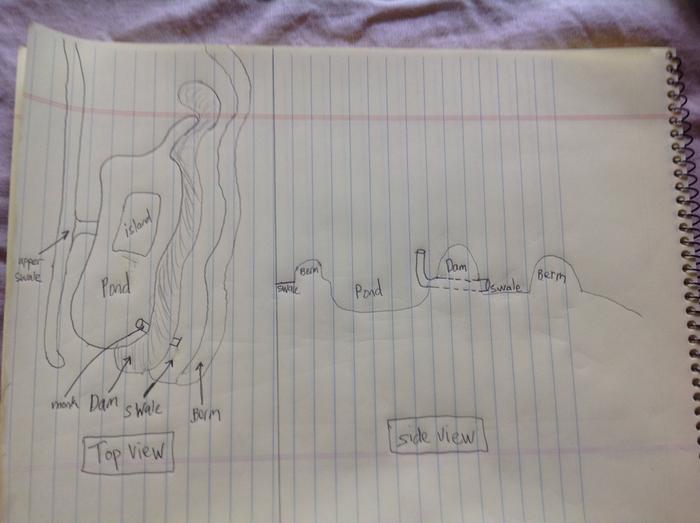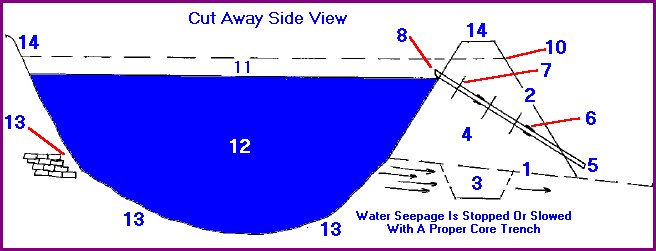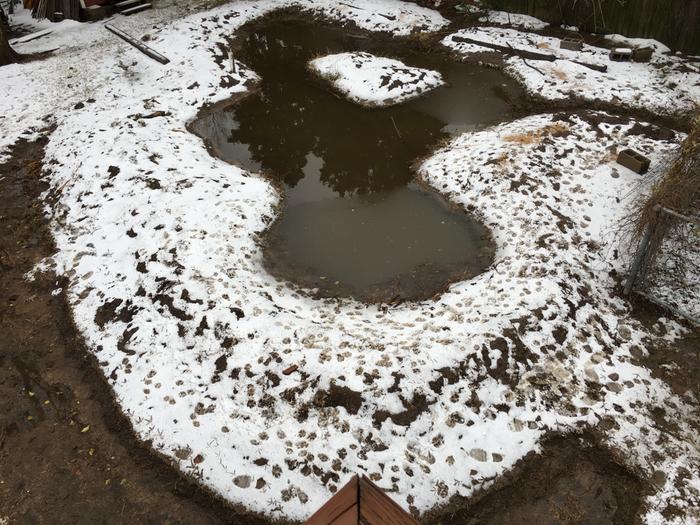
 1
1



































Zach Muller wrote:Well i am honestly not too sure about the final water height in my pond, let me explain and see if it sounds like i have my head in the right place. ( or even on my shoulders)
So when i see some farm ponds it looks like they took a place where the elevation was dropping rather significantly and pushed soil down the slope as they dug the pond to make the dam. So it ends up being like this image.
With this design the only thing holding the water is the dam.
i see what you mean water cannot go over the dam, because by that point the dam is holding too much weight and will probably fail. The difference in elevation between the top of the pond and the base of the dam is significant, so people add the culvert, or they have a part that is like a cutout significantly lower than the top of the dam. Aka spillway.
My pond is slightly different in that it is more like a hole dug out of semi level ground because the difference in elevation was minimal from the top edge to the bottom edge. So unlike the above picture the bottom edge of the pond is not entirely earth i have moved, since its a hole in the ground the lower few feet is just unmoved earth, then the dam wall sits on top of that. So the only water being held by the dam is water that is above the old ground level, which is only the top portion of water, if the water line ends up being that high.
So for example if i put my spillway level with the old ground or below (like water level a) no water will be held by the 'dam' it will be just a berm on the edge of the pond. But if i add a spillway above the old ground level (like water level b) then some water will be held by the dam. My plan is to have the spillway only slightly above the old ground level, so the water will flow around the dam and never fill up and go over. This is correct?
Is there a different name for a hole in the ground type pond, versus what is seen above in the first image?





Eric Hammond wrote:
You are correct that most ponds are simply constructed the way you say, the farmers just pushed the dirt down hill and formed a bank and called it good. And some have success doing that. However if your trying to build a pond, you can hedge your bets that it will seal if you construct it properly.
What type of equipment are you using to construct the pond? Your best bet is a machine with tracks, whether its a track hoe, or track loader. Machines with tracks are capable of compacting the earth very well. These machines with an operator will run 125- 175 dollars an hour and can do a pretty tremendous amount of work in an hour.
Since you already have a hole dug, its wise to pull a soil sample in a jar and test the clay content. Place your sample in the jar fill the jar with water and shake it to complete emulsion and leave it to sit. Sands will settle first as they are the heavy, they form the bottom layer. The next layer will be silts and loams, and the third layer will be the clay. Your shooting for a target of 30%-35% minimum clay content for a good seal.
Eric Hammond wrote:
From the sound of what your describing, I think you are trying to build a contour dam. Dams in flat lands can be some of the largest bodies of water you can construct, because you have such a surplus of material you can excavate from under the water line. As you have already done, this makes for creativity with islands and such.
Here is how I would construct it. I would excavate out the entire dam wall and build a large core trench. the dam wall is going to be in a horseshoe type of shape because its a mostly flat landscape, and the wall has to wrap around pond to seal it. The "ears" of the dam wall need to go up all the way to the swale above it. All of this dam material needs to be put in, in 6" increments and track rolled tight. I would make the full water level of the dam to be the full water height of the swale, the pond NEEDS to be connected to the swale, and not filled by the swales overflow. Use the swale to your advantage, by integrating it INTO the pond, you can still fill it, but now you can set the dams water height, via the spill way made into the swale, which can be anywhere along its length. If you get a large rain event and the spillway in the swale gets washed out, its easily reconstructed. If your dam wall gets washed away, you have no clay to replace it, and the pond is gone.
Eric Hammond wrote:
These shallow contour dams, are supposed to be VERY good fish ponds, and you could place several along the length of the swale. It might be wise to think heavily about installing pipes in the dam wall(with anti seep collars) as a means to drain the pond and harvest the fish. Have you thought about producing fish?
 1
1










Christine
Living Local at Kapelle Gardens





"Never doubt that a small group of thoughtful, committed citizens can change the world; indeed, it's the only thing that ever has."-Margaret Mead "The only thing worse than being blind, is having sight but no vision."-Helen Keller


















"Never doubt that a small group of thoughtful, committed citizens can change the world; indeed, it's the only thing that ever has."-Margaret Mead "The only thing worse than being blind, is having sight but no vision."-Helen Keller









Community Building 2.0: ask me about drL, the rotational-mob-grazing format for human interactions.

|
Whatever. Here's a tiny ad:
Support permies and give beautiful gifts to gardeners: permaculture playing cards.
https://gardener-gift.com/
|






